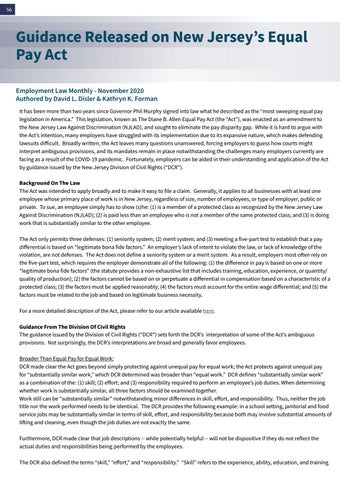56
Guidance Released on New Jersey’s Equal Pay Act Employment Law Monthly - November 2020 Authored by David L. Disler & Kathryn K. Forman It has been more than two years since Governor Phil Murphy signed into law what he described as the “most sweeping equal pay legislation in America.” This legislation, known as The Diane B. Allen Equal Pay Act (the “Act”), was enacted as an amendment to the New Jersey Law Against Discrimination (NJLAD), and sought to eliminate the pay disparity gap. While it is hard to argue with the Act’s intention, many employers have struggled with its implementation due to its expansive nature, which makes defending lawsuits difficult. Broadly written, the Act leaves many questions unanswered, forcing employers to guess how courts might interpret ambiguous provisions, and its mandates remain in place notwithstanding the challenges many employers currently are facing as a result of the COVID-19 pandemic. Fortunately, employers can be aided in their understanding and application of the Act by guidance issued by the New Jersey Division of Civil Rights (“DCR”). Background On The Law The Act was intended to apply broadly and to make it easy to file a claim. Generally, it applies to all businesses with at least one employee whose primary place of work is in New Jersey, regardless of size, number of employees, or type of employer, public or private. To sue, an employee simply has to show (s)he: (1) is a member of a protected class as recognized by the New Jersey Law Against Discrimination (NJLAD); (2) is paid less than an employee who is not a member of the same protected class; and (3) is doing work that is substantially similar to the other employee. The Act only permits three defenses: (1) seniority system; (2) merit system; and (3) meeting a five-part test to establish that a pay differential is based on “legitimate bona fide factors.” An employer’s lack of intent to violate the law, or lack of knowledge of the violation, are not defenses. The Act does not define a seniority system or a merit system. As a result, employers most often rely on the five-part test, which requires the employer demonstrate all of the following: (1) the difference in pay is based on one or more “legitimate bona fide factors” (the statute provides a non-exhaustive list that includes training, education, experience, or quantity/ quality of production); (2) the factors cannot be based on or perpetuate a differential in compensation based on a characteristic of a protected class; (3) the factors must be applied reasonably; (4) the factors must account for the entire wage differential; and (5) the factors must be related to the job and based on legitimate business necessity. For a more detailed description of the Act, please refer to our article available here. Guidance From The Division Of Civil Rights The guidance issued by the Division of Civil Rights (“DCR”) sets forth the DCR’s interpretation of some of the Act’s ambiguous provisions. Not surprisingly, the DCR’s interpretations are broad and generally favor employees. Broader Than Equal Pay for Equal Work: DCR made clear the Act goes beyond simply protecting against unequal pay for equal work; the Act protects against unequal pay for “substantially similar work,” which DCR determined was broader than “equal work.” DCR defines “substantially similar work” as a combination of the: (1) skill; (2) effort; and (3) responsibility required to perform an employee’s job duties. When determining whether work is substantially similar, all three factors should be examined together. Work still can be “substantially similar” notwithstanding minor differences in skill, effort, and responsibility. Thus, neither the job title nor the work performed needs to be identical. The DCR provides the following example: in a school setting, janitorial and food service jobs may be substantially similar in terms of skill, effort, and responsibility because both may involve substantial amounts of lifting and cleaning, even though the job duties are not exactly the same. Furthermore, DCR made clear that job descriptions -- while potentially helpful -- will not be dispositive if they do not reflect the actual duties and responsibilities being performed by the employees. The DCR also defined the terms “skill,” “effort,” and “responsibility.” “Skill” refers to the experience, ability, education, and training

















